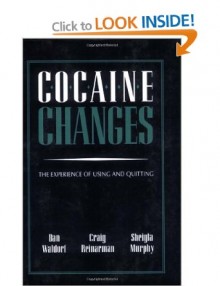While cocaine is portrayed as having a very high addiction potential, the majority of people who use the drug do not have a problem. Research by Dan Waldorf and colleagues reveals a number of social and social psychological factors that influence how a person uses a drug. (887 words)
Cocaine is often portrayed as having a very high addiction potential, and that most people who use it are risking serious physiological and psychological harm. Whilst some cocaine users do develop difficulties, the majority do not.
The most comprehensive ethnographic study of heavy cocaine users was conducted by Dan Waldorf and colleagues in Northern California. They interviewed 267 current and former heavy users of cocaine, a sample that did not include people in treatment programmes or in prison. Most of the respondents were ‘solidly working- or middle-class, fairly well-educated, and steadily employed.’
These researchers showed that about a half of interviewees maintained a controlled pattern of cocaine use, some of them for even up to a decade. According to Waldorf, controlled use can be defined as either, ‘regular ingestion without escalation to abuse or addiction, and without disruption of daily social functioning’, or ‘a pattern in which users do not ingest more than they want to and which does not result in any dysfunction in the roles and responsibilities of daily life.’
Based on their observations, Waldorf and colleagues described the ideal type of controlled users:
- ‘Controlled users tended to be people who did not use cocaine to help them manage pre-existing psychological problems, and did not also abuse other drugs, especially alcohol.
- Controlled users generally had a multiplicity of meaningful roles which gave them a positive identity and a stake in conventional life (e.g., secure employment, homes, families). Both of these anchored them against drifting toward a drug-centered life.
- Controlled users, perhaps because they are more anchored in meaningful lives and identities, were more often able to develop, and stick to, rules, routines, and rituals that helped them limit their cocaine use to specific times, places, occasions, amounts, or spheres of activity.’
This research suggests that a stake in conventional life and identity are central for understanding continued controlled use. Such stakes seem to keep a person’s drug use from overtaking their life and identity. They also facilitate an individual reasserting control after a period of problematic use (I will discuss this issue in a later Briefing).
The fact that these social and social psychological factors mitigate against cocaine misuse and related problems suggests that not everyone need develop a problem with cocaine, even when using heavily as this population was.
At the same time, it follows that those people with the least stake in conventional life may be at the highest risk for problematic cocaine use. Cocaine, and in particular crack, have had a marked impact in poor neighbourhoods, causing problems to many individuals and communities.
Obviously, these forms of social control are not fool-proof for maintaining controlled use. Some people with a large investment in conventional life did lose control of their cocaine use and develop serious problems. Waldorf and colleagues report that:
‘… after scouring our other interview transcripts, we could not put our fingers on any one magical ‘factor X’ that explained why some people get into trouble and others did not.’
Other researchers in the US and other countries have reported controlled use of cocaine by a significant proportion of users (see Decorte, 2000 for review).
Waldorf and colleagues recognise that some well-intentioned parents and policy makers might not want to broadcast findings about controlled use for fear of facilitating the denial of some misusers or increasing the risks for some new users.
However, they contend that the:
‘… considerable possibilities for exercising control over cocaine use can be seen as cultural resources that can facilitate personal capacities for control and social capabilities for harm reduction.’
The researchers made the very good point that if the only frameworks in society for interpreting one’s drug-using behaviour are addiction and abstinence, then the idea that one can and should exercise control can atrophy. The interviews revealed that one important reason that control was possible for so many of the participants was that they believed that it was possible. They believed that cocaine was ‘not necessarily addicting, that it could and should be used in a controlled fashion.’
Whilst cocaine is often portrayed as a powerful reinforcing psychoactive drug, we sadly do not often hear that its powers are also mediated by users’ norms, values, practices, and circumstances. We underestimate the powers of social, social psychological and cultural aspects, whilst overestimating the pharmacological power of the drug.
Waldorf and colleagues point out that heavy cocaine users have taught us:
‘… that beyond the drug itself, how users think about and behave towards drugs matters a great deal. Cultural norms matter. Subcultural practices matter. How closely we look out for each other matters. The uses to which we put consciousness-altering substances matters. The personal and social resources of users matter. The values placed on productive daily lives matters. And, of course, the social distribution of opportunities for productive lives matters…’
Recommended reading:
Cocaine Changes: The Experience of Using and Quitting by Dan Waldorf, Craig Reinarman and Sheigla Murphy. Temple University Press, USA.
The Taming of Cocaine: Cocaine Use in European and American cities by Tom Decorte. VUB University Press, Belgium.
> Part 3



